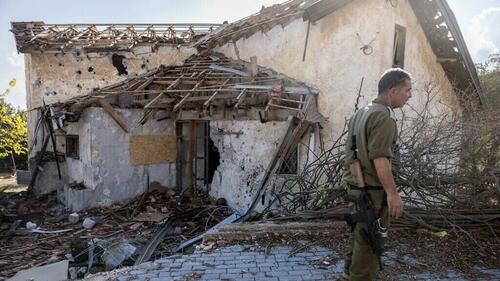Nearly 10,000 Buildings Destroyed By Hezbollah In Israel’s North: Report
More than 9,000 buildings and 7,000 vehicles have been damaged or destroyed by Hezbollah operations against the Israeli north since the start of the war, Yedioth Ahronoth reported on Tuesday – highlighting the “unimaginable” losses ahead of a potential ceasefire deal with Lebanon.
“In the conflict line settlements, there is almost no building that does not require renovation – or demolition and rebuilding,” said the Israeli newspaper’s electronic site Ynet.

According to property tax data obtained by Ynet, “a disturbing partial image emerges that indicates destruction and damage to approximately 9,000 buildings and over 7,000 vehicles that were damaged mainly by Hezbollah fire.”
Ynet adds that “about NIS 140 million [$38,368,316] has been paid to compensate for the damages.”
The data indicates that “there are many injuries in the north that have not yet been reported, because the tenants are being evacuated or because the injuries are in areas that cannot be entered according to the army’s instructions.”
The report highlights that the northern settlements and cities of Kiryat Shmona, Manara, Shtula, Zarit, Nahariya, and Shlomi sustained the heaviest damage throughout the war. Most of the damage was to residential buildings. The Hebrew outlet says the destruction has not been properly documented and is “shrouded in a heavy fog.”
In Kiryat Shmona, the losses are “unimaginable.” Its Mayor, Avichai Stern, reported that every home in Kiryat Shmona needs renovation, which will take months. Public buildings have also been damaged, and renovation of schools alone requires around four months.
Stern states that there is no government plan in place to receive the settlers back north. He says they will decide to leave again once they see the reality they returned to. “When they see where they returned and to what reality they returned – the second wave of departure will be wider.”
“Apart from a budget framework of NIS 15 billion [$4,119,765,000] for all the settlements in the north, there is no plan approved by the government. Not security, not economic, not social, and not any response to resilience, and the communities that fell apart and the infrastructures that were destroyed,” he added.
“The State of Israel has no idea what the extent of the damage is and what needs to be done and treated the day after the war,” says Moshe Davidovitz, chairman of the Conflict Line Settlements Forum.
The first months of the war last year saw Hezbollah meticulously target border settlements, nearby bases, and military sites. As Israel continued to escalate, Hezbollah’s operations gradually extended deeper north.
After the pager terror attacks in Lebanon and the assassination of Hezbollah’s secretary-general Hassan Nasrallah, and in the weeks that followed, Haifa and Tel Aviv entered the Lebanese resistance’s range of fire.
The Ynet report comes ahead of an expected announcement of a ceasefire agreement between Hezbollah and Israel, which US and Israeli officials say is close. Israel’s Prime Minister Benjamin Netanyahu is expected to approve the deal during a security cabinet meeting on Tuesday afternoon.
Hezbollah published video of a drone fired on an IDF military base in northern Israel.
—
A trend I’ve noticed over the course of the war is that Hezbollah has revealed more about how their fighters launch attacks against Israel. Hezbollah would often heavily blur their videos,… pic.twitter.com/RnpXMyRgui— Joe Truzman (@JoeTruzman) November 26, 2024
Beirut has expressed cautious optimism, as Netanyahu has consistently blocked a deal from going through in Gaza for over a year. The agreement focuses on UN Resolution 1701. As part of the deal, Hezbollah is required to withdraw beyond the Litani River, with the Lebanese army deploying its forces south.
Yet Israelis and the settler officials from the battered north are furious about the potential agreement and are far from satisfied with the fact that the deal reportedly stipulates that Lebanese army forces are responsible for dismantling Hezbollah infrastructure along the border.
The settlers feel the government has abandoned them. Many refuse to return to the ravaged wasteland from which they were forced to evacuate at the start of the fighting, as they feel Hezbollah has not been deterred and view the agreement as a surrender.
Tyler Durden
Tue, 11/26/2024 – 13:20

